1997 SSANGYONG KORANDO belt
[x] Cancel search: beltPage 1588 of 2053
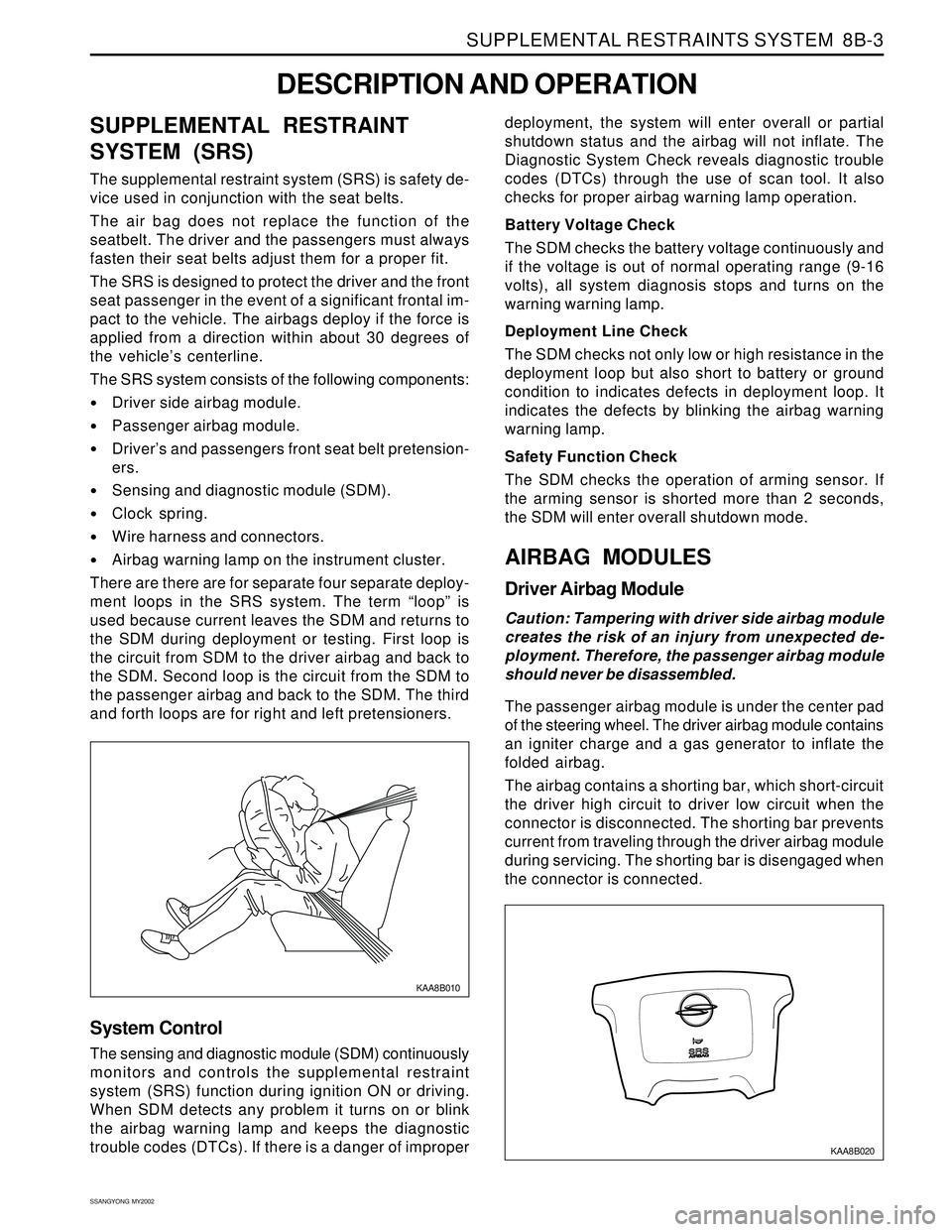
SUPPLEMENTAL RESTRAINTS SYSTEM 8B-3
SSANGYONG MY2002
SUPPLEMENTAL RESTRAINT
SYSTEM (SRS)
The supplemental restraint system (SRS) is safety de-
vice used in conjunction with the seat belts.
The air bag does not replace the function of the
seatbelt. The driver and the passengers must always
fasten their seat belts adjust them for a proper fit.
The SRS is designed to protect the driver and the front
seat passenger in the event of a significant frontal im-
pact to the vehicle. The airbags deploy if the force is
applied from a direction within about 30 degrees of
the vehicle’s centerline.
The SRS system consists of the following components:
Driver side airbag module.
Passenger airbag module.
Driver’s and passengers front seat belt pretension-
ers.
Sensing and diagnostic module (SDM).
Clock spring.
Wire harness and connectors.
Airbag warning lamp on the instrument cluster.
There are there are for separate four separate deploy-
ment loops in the SRS system. The term “loop” is
used because current leaves the SDM and returns to
the SDM during deployment or testing. First loop is
the circuit from SDM to the driver airbag and back to
the SDM. Second loop is the circuit from the SDM to
the passenger airbag and back to the SDM. The third
and forth loops are for right and left pretensioners.
DESCRIPTION AND OPERATION
KAA8B010
deployment, the system will enter overall or partial
shutdown status and the airbag will not inflate. The
Diagnostic System Check reveals diagnostic trouble
codes (DTCs) through the use of scan tool. It also
checks for proper airbag warning lamp operation.
Battery Voltage Check
The SDM checks the battery voltage continuously and
if the voltage is out of normal operating range (9-16
volts), all system diagnosis stops and turns on the
warning warning lamp.
Deployment Line Check
The SDM checks not only low or high resistance in the
deployment loop but also short to battery or ground
condition to indicates defects in deployment loop. It
indicates the defects by blinking the airbag warning
warning lamp.
Safety Function Check
The SDM checks the operation of arming sensor. If
the arming sensor is shorted more than 2 seconds,
the SDM will enter overall shutdown mode.
AIRBAG MODULES
Driver Airbag Module
Caution: Tampering with driver side airbag module
creates the risk of an injury from unexpected de-
ployment. Therefore, the passenger airbag module
should never be disassembled.
The passenger airbag module is under the center pad
of the steering wheel. The driver airbag module contains
an igniter charge and a gas generator to inflate the
folded airbag.
The airbag contains a shorting bar, which short-circuit
the driver high circuit to driver low circuit when the
connector is disconnected. The shorting bar prevents
current from traveling through the driver airbag module
during servicing. The shorting bar is disengaged when
the connector is connected.
System Control
The sensing and diagnostic module (SDM) continuously
monitors and controls the supplemental restraint
system (SRS) function during ignition ON or driving.
When SDM detects any problem it turns on or blink
the airbag warning lamp and keeps the diagnostic
trouble codes (DTCs). If there is a danger of improper
KAA8B020
Page 1589 of 2053
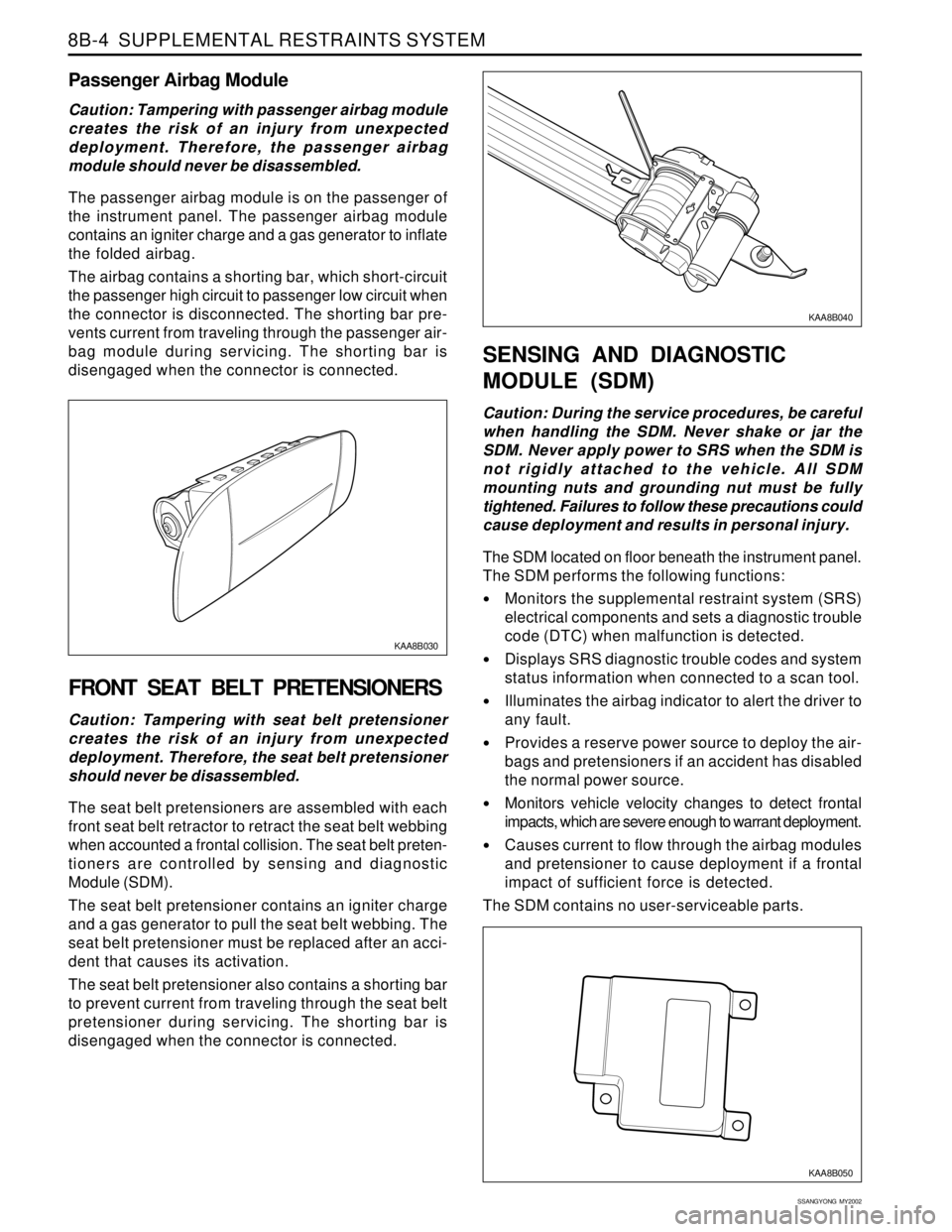
SSANGYONG MY2002
8B-4 SUPPLEMENTAL RESTRAINTS SYSTEM
KAA8B030
KAA8B040
Passenger Airbag Module
Caution: Tampering with passenger airbag module
creates the risk of an injury from unexpected
deployment. Therefore, the passenger airbag
module should never be disassembled.
The passenger airbag module is on the passenger of
the instrument panel. The passenger airbag module
contains an igniter charge and a gas generator to inflate
the folded airbag.
The airbag contains a shorting bar, which short-circuit
the passenger high circuit to passenger low circuit when
the connector is disconnected. The shorting bar pre-
vents current from traveling through the passenger air-
bag module during servicing. The shorting bar is
disengaged when the connector is connected.
FRONT SEAT BELT PRETENSIONERS
Caution: Tampering with seat belt pretensioner
creates the risk of an injury from unexpected
deployment. Therefore, the seat belt pretensioner
should never be disassembled.
The seat belt pretensioners are assembled with each
front seat belt retractor to retract the seat belt webbing
when accounted a frontal collision. The seat belt preten-
tioners are controlled by sensing and diagnostic
Module (SDM).
The seat belt pretensioner contains an igniter charge
and a gas generator to pull the seat belt webbing. The
seat belt pretensioner must be replaced after an acci-
dent that causes its activation.
The seat belt pretensioner also contains a shorting bar
to prevent current from traveling through the seat belt
pretensioner during servicing. The shorting bar is
disengaged when the connector is connected.
SENSING AND DIAGNOSTIC
MODULE (SDM)
Caution: During the service procedures, be careful
when handling the SDM. Never shake or jar the
SDM. Never apply power to SRS when the SDM is
not rigidly attached to the vehicle. All SDM
mounting nuts and grounding nut must be fully
tightened. Failures to follow these precautions could
cause deployment and results in personal injury.
The SDM located on floor beneath the instrument panel.
The SDM performs the following functions:
Monitors the supplemental restraint system (SRS)
electrical components and sets a diagnostic trouble
code (DTC) when malfunction is detected.
Displays SRS diagnostic trouble codes and system
status information when connected to a scan tool.
Illuminates the airbag indicator to alert the driver to
any fault.
Provides a reserve power source to deploy the air-
bags and pretensioners if an accident has disabled
the normal power source.
Monitors vehicle velocity changes to detect frontal
impacts, which are severe enough to warrant deployment.
Causes current to flow through the airbag modules
and pretensioner to cause deployment if a frontal
impact of sufficient force is detected.
The SDM contains no user-serviceable parts.
KAA8B050
Page 1590 of 2053
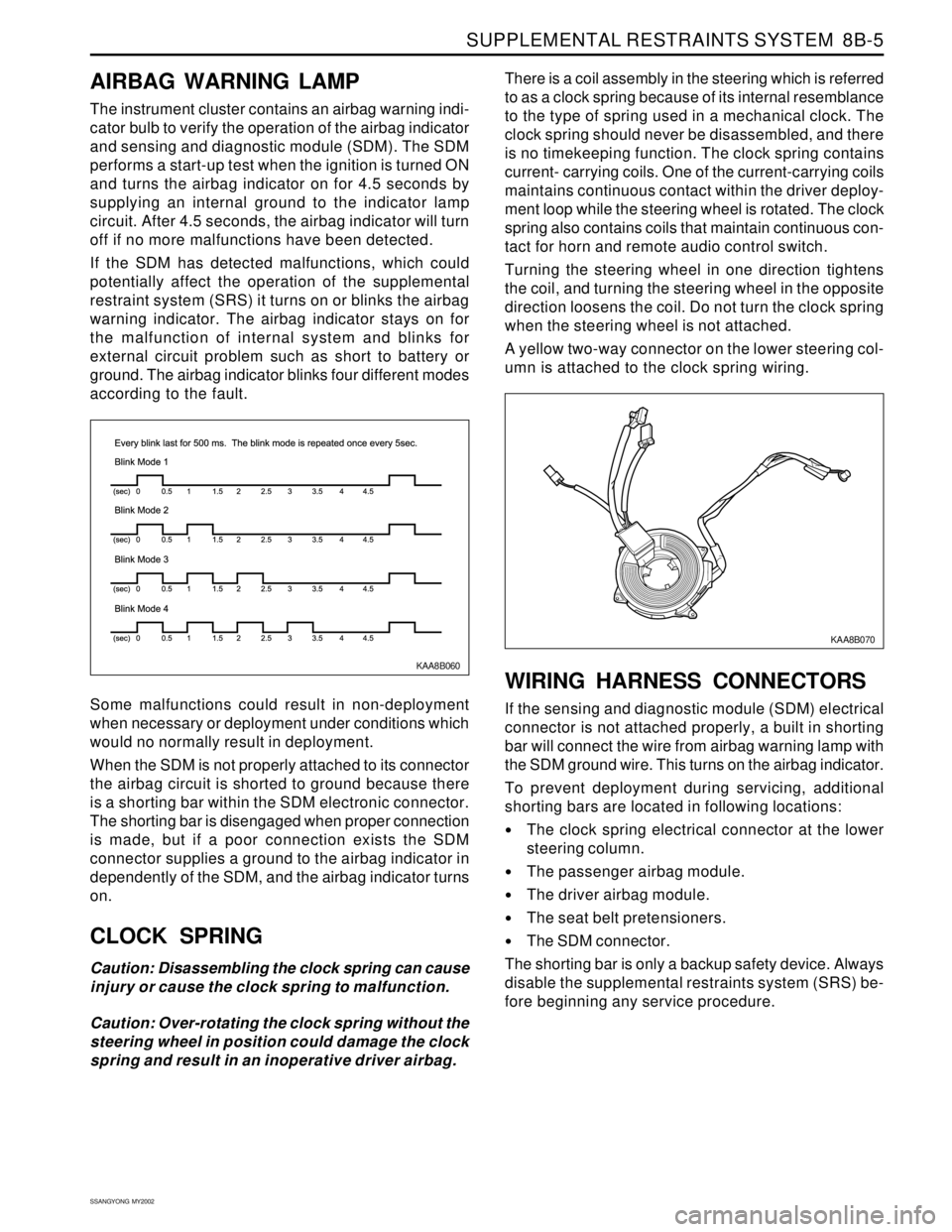
SUPPLEMENTAL RESTRAINTS SYSTEM 8B-5
SSANGYONG MY2002
KAA8B060
AIRBAG WARNING LAMP
The instrument cluster contains an airbag warning indi-
cator bulb to verify the operation of the airbag indicator
and sensing and diagnostic module (SDM). The SDM
performs a start-up test when the ignition is turned ON
and turns the airbag indicator on for 4.5 seconds by
supplying an internal ground to the indicator lamp
circuit. After 4.5 seconds, the airbag indicator will turn
off if no more malfunctions have been detected.
If the SDM has detected malfunctions, which could
potentially affect the operation of the supplemental
restraint system (SRS) it turns on or blinks the airbag
warning indicator. The airbag indicator stays on for
the malfunction of internal system and blinks for
external circuit problem such as short to battery or
ground. The airbag indicator blinks four different modes
according to the fault.
Some malfunctions could result in non-deployment
when necessary or deployment under conditions which
would no normally result in deployment.
When the SDM is not properly attached to its connector
the airbag circuit is shorted to ground because there
is a shorting bar within the SDM electronic connector.
The shorting bar is disengaged when proper connection
is made, but if a poor connection exists the SDM
connector supplies a ground to the airbag indicator in
dependently of the SDM, and the airbag indicator turns
on.
CLOCK SPRING
Caution: Disassembling the clock spring can cause
injury or cause the clock spring to malfunction.
Caution: Over-rotating the clock spring without the
steering wheel in position could damage the clock
spring and result in an inoperative driver airbag.There is a coil assembly in the steering which is referred
to as a clock spring because of its internal resemblance
to the type of spring used in a mechanical clock. The
clock spring should never be disassembled, and there
is no timekeeping function. The clock spring contains
current- carrying coils. One of the current-carrying coils
maintains continuous contact within the driver deploy-
ment loop while the steering wheel is rotated. The clock
spring also contains coils that maintain continuous con-
tact for horn and remote audio control switch.
Turning the steering wheel in one direction tightens
the coil, and turning the steering wheel in the opposite
direction loosens the coil. Do not turn the clock spring
when the steering wheel is not attached.
A yellow two-way connector on the lower steering col-
umn is attached to the clock spring wiring.
WIRING HARNESS CONNECTORS
If the sensing and diagnostic module (SDM) electrical
connector is not attached properly, a built in shorting
bar will connect the wire from airbag warning lamp with
the SDM ground wire. This turns on the airbag indicator.
To prevent deployment during servicing, additional
shorting bars are located in following locations:
The clock spring electrical connector at the lower
steering column.
The passenger airbag module.
The driver airbag module.
The seat belt pretensioners.
The SDM connector.
The shorting bar is only a backup safety device. Always
disable the supplemental restraints system (SRS) be-
fore beginning any service procedure.
KAA8B070
Page 1592 of 2053
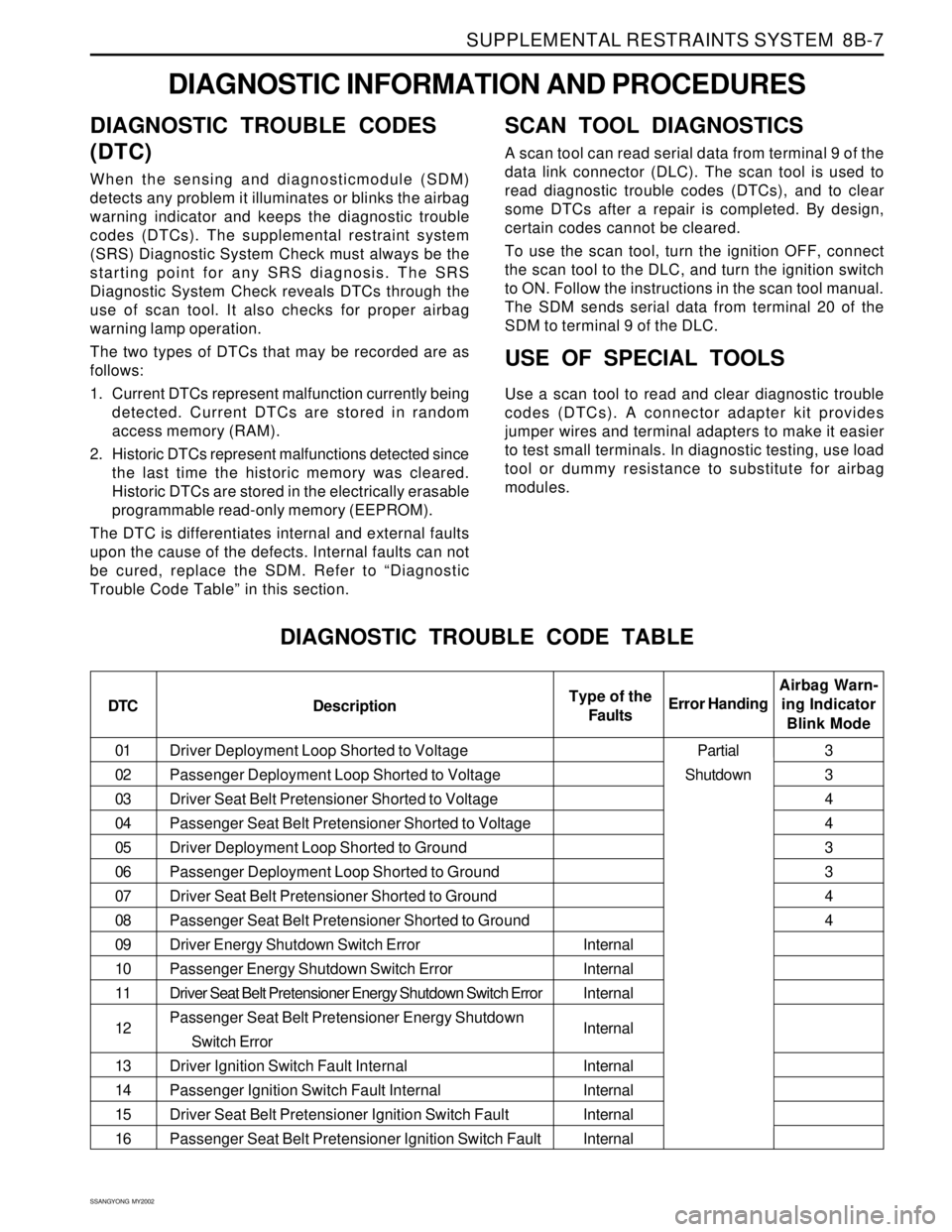
SUPPLEMENTAL RESTRAINTS SYSTEM 8B-7
SSANGYONG MY2002
Driver Deployment Loop Shorted to Voltage
Passenger Deployment Loop Shorted to Voltage
Driver Seat Belt Pretensioner Shorted to Voltage
Passenger Seat Belt Pretensioner Shorted to Voltage
Driver Deployment Loop Shorted to Ground
Passenger Deployment Loop Shorted to Ground
Driver Seat Belt Pretensioner Shorted to Ground
Passenger Seat Belt Pretensioner Shorted to Ground
Driver Energy Shutdown Switch Error
Passenger Energy Shutdown Switch Error
Driver Seat Belt Pretensioner Energy Shutdown Switch Error
Passenger Seat Belt Pretensioner Energy Shutdown
Switch Error
Driver Ignition Switch Fault Internal
Passenger Ignition Switch Fault Internal
Driver Seat Belt Pretensioner Ignition Switch Fault
Passenger Seat Belt Pretensioner Ignition Switch Fault 01
02
03
04
05
06
07
08
09
10
11
12
13
14
15
16
DIAGNOSTIC INFORMATION AND PROCEDURES
DIAGNOSTIC TROUBLE CODES
(DTC)
When the sensing and diagnosticmodule (SDM)
detects any problem it illuminates or blinks the airbag
warning indicator and keeps the diagnostic trouble
codes (DTCs). The supplemental restraint system
(SRS) Diagnostic System Check must always be the
starting point for any SRS diagnosis. The SRS
Diagnostic System Check reveals DTCs through the
use of scan tool. It also checks for proper airbag
warning lamp operation.
The two types of DTCs that may be recorded are as
follows:
1. Current DTCs represent malfunction currently being
detected. Current DTCs are stored in random
access memory (RAM).
2. Historic DTCs represent malfunctions detected since
the last time the historic memory was cleared.
Historic DTCs are stored in the electrically erasable
programmable read-only memory (EEPROM).
The DTC is differentiates internal and external faults
upon the cause of the defects. Internal faults can not
be cured, replace the SDM. Refer to “Diagnostic
Trouble Code Table” in this section.
SCAN TOOL DIAGNOSTICS
A scan tool can read serial data from terminal 9 of the
data link connector (DLC). The scan tool is used to
read diagnostic trouble codes (DTCs), and to clear
some DTCs after a repair is completed. By design,
certain codes cannot be cleared.
To use the scan tool, turn the ignition OFF, connect
the scan tool to the DLC, and turn the ignition switch
to ON. Follow the instructions in the scan tool manual.
The SDM sends serial data from terminal 20 of the
SDM to terminal 9 of the DLC.
USE OF SPECIAL TOOLS
Use a scan tool to read and clear diagnostic trouble
codes (DTCs). A connector adapter kit provides
jumper wires and terminal adapters to make it easier
to test small terminals. In diagnostic testing, use load
tool or dummy resistance to substitute for airbag
modules.
DIAGNOSTIC TROUBLE CODE TABLE
DTC DescriptionAirbag Warn-
ing Indicator
Blink Mode Error HandingType of the
Faults
Internal
Internal
Internal
Internal
Internal
Internal
Internal
Internal3
3
4
4
3
3
4
4
Partial
Shutdown
Page 1593 of 2053
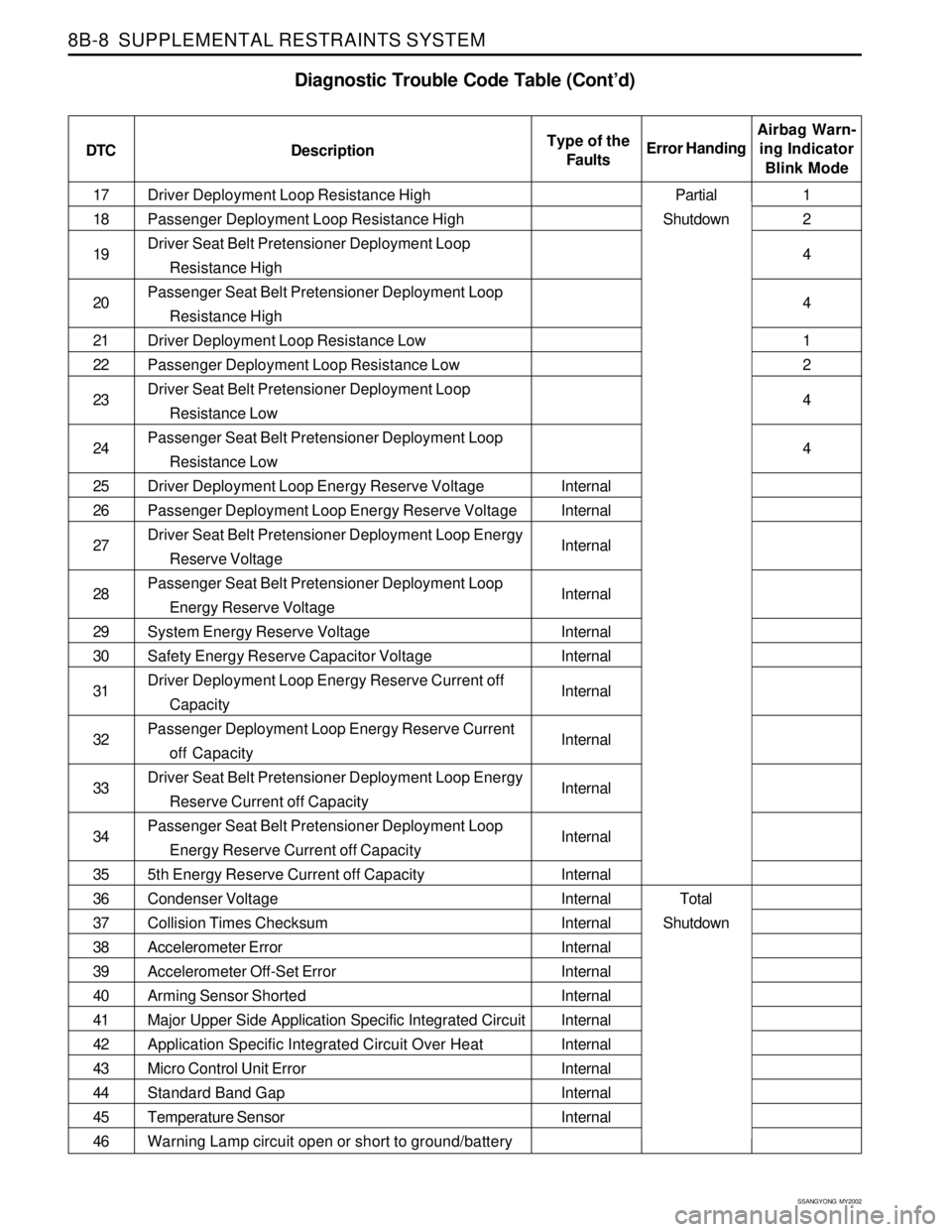
SSANGYONG MY2002
8B-8 SUPPLEMENTAL RESTRAINTS SYSTEM
Driver Deployment Loop Resistance High
Passenger Deployment Loop Resistance High
Driver Seat Belt Pretensioner Deployment Loop
Resistance High
Passenger Seat Belt Pretensioner Deployment Loop
Resistance High
Driver Deployment Loop Resistance Low
Passenger Deployment Loop Resistance Low
Driver Seat Belt Pretensioner Deployment Loop
Resistance Low
Passenger Seat Belt Pretensioner Deployment Loop
Resistance Low
Driver Deployment Loop Energy Reserve Voltage
Passenger Deployment Loop Energy Reserve Voltage
Driver Seat Belt Pretensioner Deployment Loop Energy
Reserve Voltage
Passenger Seat Belt Pretensioner Deployment Loop
Energy Reserve Voltage
System Energy Reserve Voltage
Safety Energy Reserve Capacitor Voltage
Driver Deployment Loop Energy Reserve Current off
Capacity
Passenger Deployment Loop Energy Reserve Current
off Capacity
Driver Seat Belt Pretensioner Deployment Loop Energy
Reserve Current off Capacity
Passenger Seat Belt Pretensioner Deployment Loop
Energy Reserve Current off Capacity
5th Energy Reserve Current off Capacity
Condenser Voltage
Collision Times Checksum
Accelerometer Error
Accelerometer Off-Set Error
Arming Sensor Shorted
Major Upper Side Application Specific Integrated Circuit
Application Specific Integrated Circuit Over Heat
Micro Control Unit Error
Standard Band Gap
Temperature Sensor
Warning Lamp circuit open or short to ground/battery 17
18
19
20
21
22
23
24
25
26
27
28
29
30
31
32
33
34
35
36
37
38
39
40
41
42
43
44
45
46
Diagnostic Trouble Code Table (Cont’d)
DTC DescriptionAirbag Warn-
ing Indicator
Blink Mode Error HandingType of the
Faults
Internal
Internal
Internal
Internal
Internal
Internal
Internal
Internal
Internal
Internal
Internal
Internal
Internal
Internal
Internal
Internal
Internal
Internal
Internal
Internal
Internal1
2
4
4
1
2
4
4
Partial
Shutdown
Total
Shutdown
Page 1602 of 2053
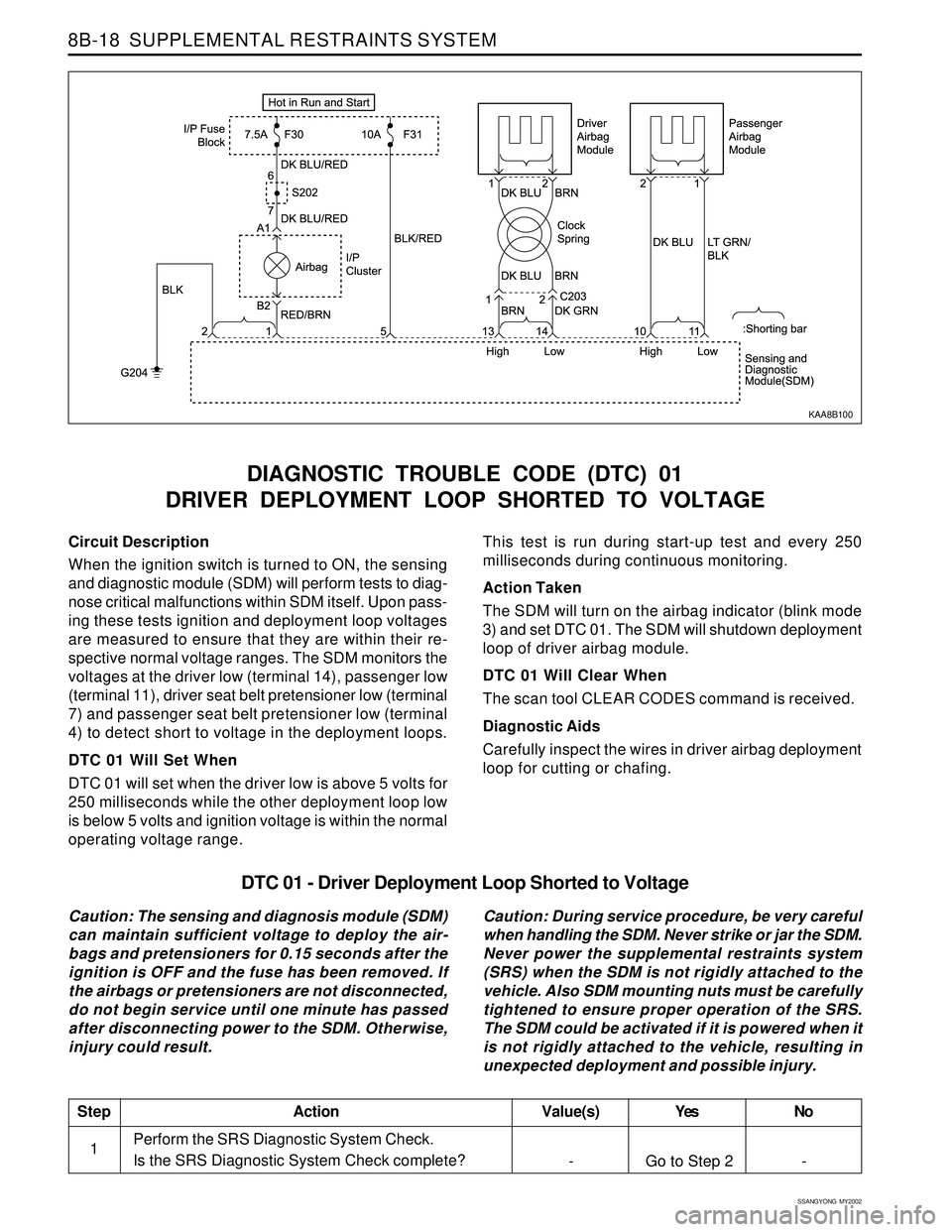
SSANGYONG MY2002
8B-18 SUPPLEMENTAL RESTRAINTS SYSTEM
Circuit Description
When the ignition switch is turned to ON, the sensing
and diagnostic module (SDM) will perform tests to diag-
nose critical malfunctions within SDM itself. Upon pass-
ing these tests ignition and deployment loop voltages
are measured to ensure that they are within their re-
spective normal voltage ranges. The SDM monitors the
voltages at the driver low (terminal 14), passenger low
(terminal 11), driver seat belt pretensioner low (terminal
7) and passenger seat belt pretensioner low (terminal
4) to detect short to voltage in the deployment loops.
DTC 01 Will Set When
DTC 01 will set when the driver low is above 5 volts for
250 milliseconds while the other deployment loop low
is below 5 volts and ignition voltage is within the normal
operating voltage range.
DIAGNOSTIC TROUBLE CODE (DTC) 01
DRIVER DEPLOYMENT LOOP SHORTED TO VOLTAGE
This test is run during start-up test and every 250
milliseconds during continuous monitoring.
Action Taken
The SDM will turn on the airbag indicator (blink mode
3) and set DTC 01. The SDM will shutdown deployment
loop of driver airbag module.
DTC 01 Will Clear When
The scan tool CLEAR CODES command is received.
Diagnostic Aids
Carefully inspect the wires in driver airbag deployment
loop for cutting or chafing.
KAA8B100
DTC 01 - Driver Deployment Loop Shorted to Voltage
Caution: The sensing and diagnosis module (SDM)
can maintain sufficient voltage to deploy the air-
bags and pretensioners for 0.15 seconds after the
ignition is OFF and the fuse has been removed. If
the airbags or pretensioners are not disconnected,
do not begin service until one minute has passed
after disconnecting power to the SDM. Otherwise,
injury could result.Caution: During service procedure, be very careful
when handling the SDM. Never strike or jar the SDM.
Never power the supplemental restraints system
(SRS) when the SDM is not rigidly attached to the
vehicle. Also SDM mounting nuts must be carefully
tightened to ensure proper operation of the SRS.
The SDM could be activated if it is powered when it
is not rigidly attached to the vehicle, resulting in
unexpected deployment and possible injury.
Perform the SRS Diagnostic System Check.
Is the SRS Diagnostic System Check complete?
StepAction Value(s) Yes No
1-
Go to Step 2 -
Page 1604 of 2053
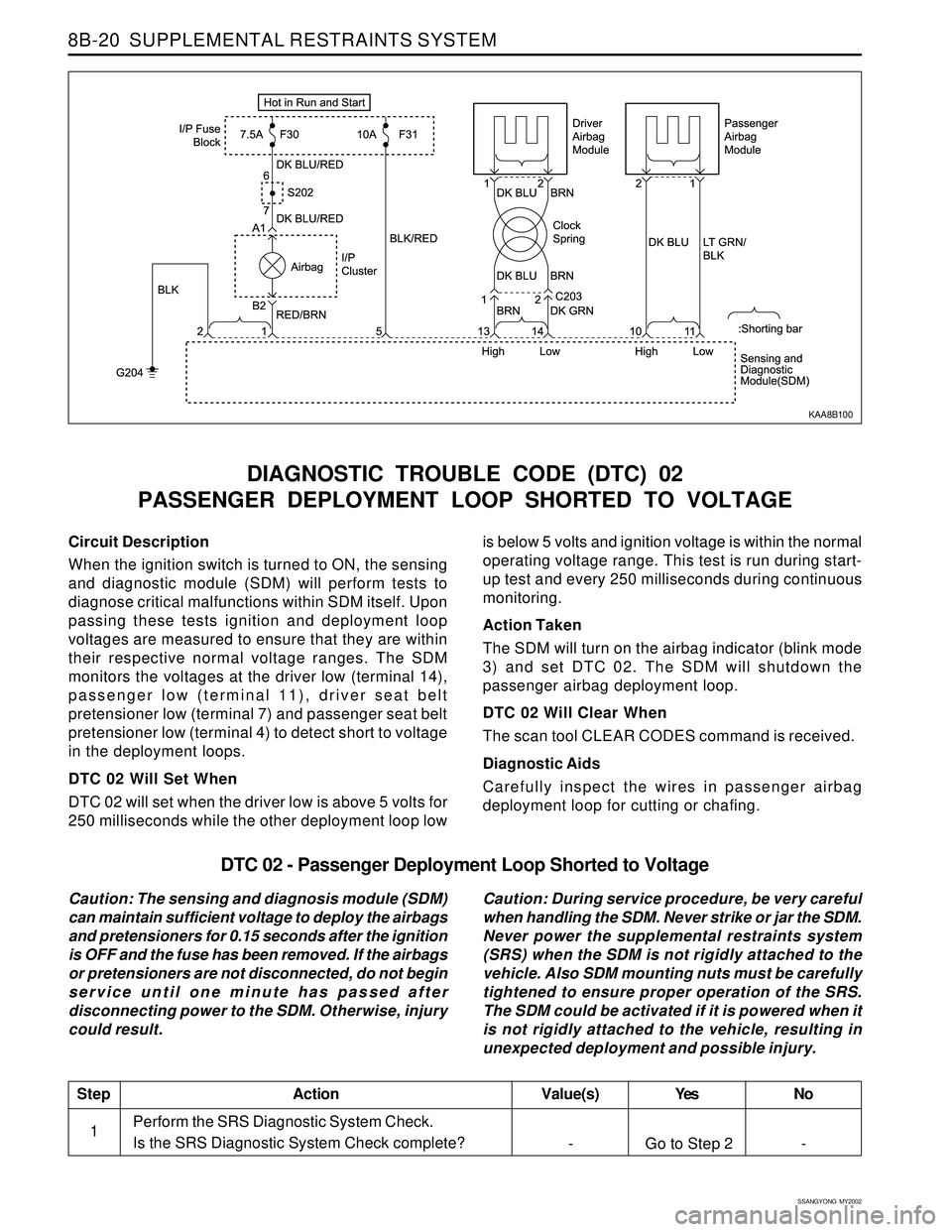
SSANGYONG MY2002
8B-20 SUPPLEMENTAL RESTRAINTS SYSTEM
Circuit Description
When the ignition switch is turned to ON, the sensing
and diagnostic module (SDM) will perform tests to
diagnose critical malfunctions within SDM itself. Upon
passing these tests ignition and deployment loop
voltages are measured to ensure that they are within
their respective normal voltage ranges. The SDM
monitors the voltages at the driver low (terminal 14),
passenger low (terminal 11), driver seat belt
pretensioner low (terminal 7) and passenger seat belt
pretensioner low (terminal 4) to detect short to voltage
in the deployment loops.
DTC 02 Will Set When
DTC 02 will set when the driver low is above 5 volts for
250 milliseconds while the other deployment loop low
DIAGNOSTIC TROUBLE CODE (DTC) 02
PASSENGER DEPLOYMENT LOOP SHORTED TO VOLTAGE
is below 5 volts and ignition voltage is within the normal
operating voltage range. This test is run during start-
up test and every 250 milliseconds during continuous
monitoring.
Action Taken
The SDM will turn on the airbag indicator (blink mode
3) and set DTC 02. The SDM will shutdown the
passenger airbag deployment loop.
DTC 02 Will Clear When
The scan tool CLEAR CODES command is received.
Diagnostic Aids
Carefully inspect the wires in passenger airbag
deployment loop for cutting or chafing.
KAA8B100
DTC 02 - Passenger Deployment Loop Shorted to Voltage
Caution: The sensing and diagnosis module (SDM)
can maintain sufficient voltage to deploy the airbags
and pretensioners for 0.15 seconds after the ignition
is OFF and the fuse has been removed. If the airbags
or pretensioners are not disconnected, do not begin
service until one minute has passed after
disconnecting power to the SDM. Otherwise, injury
could result.Caution: During service procedure, be very careful
when handling the SDM. Never strike or jar the SDM.
Never power the supplemental restraints system
(SRS) when the SDM is not rigidly attached to the
vehicle. Also SDM mounting nuts must be carefully
tightened to ensure proper operation of the SRS.
The SDM could be activated if it is powered when it
is not rigidly attached to the vehicle, resulting in
unexpected deployment and possible injury.
Perform the SRS Diagnostic System Check.
Is the SRS Diagnostic System Check complete?
StepAction Value(s) Yes No
1- Go to Step 2 -
Page 1606 of 2053
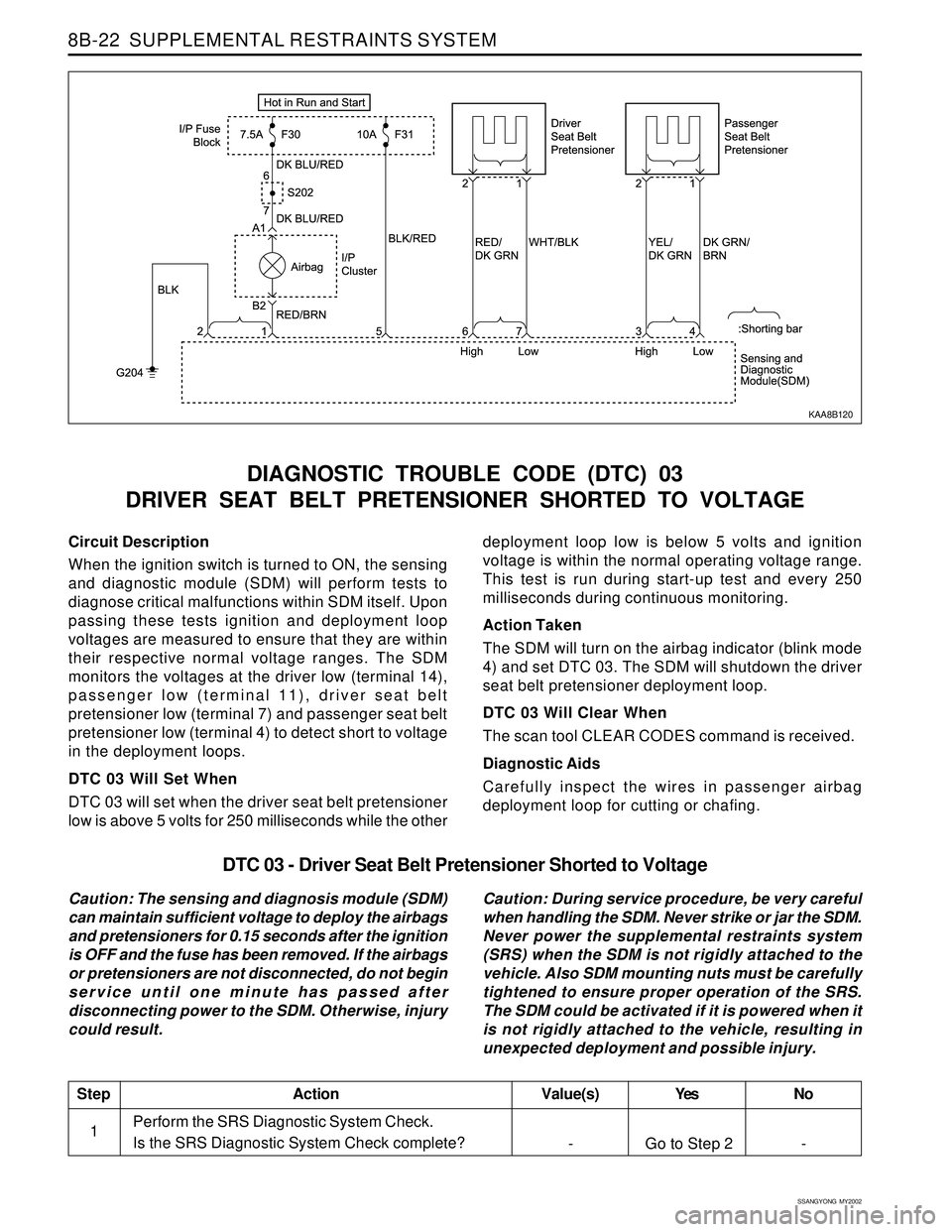
SSANGYONG MY2002
8B-22 SUPPLEMENTAL RESTRAINTS SYSTEM
Circuit Description
When the ignition switch is turned to ON, the sensing
and diagnostic module (SDM) will perform tests to
diagnose critical malfunctions within SDM itself. Upon
passing these tests ignition and deployment loop
voltages are measured to ensure that they are within
their respective normal voltage ranges. The SDM
monitors the voltages at the driver low (terminal 14),
passenger low (terminal 11), driver seat belt
pretensioner low (terminal 7) and passenger seat belt
pretensioner low (terminal 4) to detect short to voltage
in the deployment loops.
DTC 03 Will Set When
DTC 03 will set when the driver seat belt pretensioner
low is above 5 volts for 250 milliseconds while the other
DIAGNOSTIC TROUBLE CODE (DTC) 03
DRIVER SEAT BELT PRETENSIONER SHORTED TO VOLTAGE
deployment loop low is below 5 volts and ignition
voltage is within the normal operating voltage range.
This test is run during start-up test and every 250
milliseconds during continuous monitoring.
Action Taken
The SDM will turn on the airbag indicator (blink mode
4) and set DTC 03. The SDM will shutdown the driver
seat belt pretensioner deployment loop.
DTC 03 Will Clear When
The scan tool CLEAR CODES command is received.
Diagnostic Aids
Carefully inspect the wires in passenger airbag
deployment loop for cutting or chafing.
KAA8B120
DTC 03 - Driver Seat Belt Pretensioner Shorted to Voltage
Caution: The sensing and diagnosis module (SDM)
can maintain sufficient voltage to deploy the airbags
and pretensioners for 0.15 seconds after the ignition
is OFF and the fuse has been removed. If the airbags
or pretensioners are not disconnected, do not begin
service until one minute has passed after
disconnecting power to the SDM. Otherwise, injury
could result.Caution: During service procedure, be very careful
when handling the SDM. Never strike or jar the SDM.
Never power the supplemental restraints system
(SRS) when the SDM is not rigidly attached to the
vehicle. Also SDM mounting nuts must be carefully
tightened to ensure proper operation of the SRS.
The SDM could be activated if it is powered when it
is not rigidly attached to the vehicle, resulting in
unexpected deployment and possible injury.
Perform the SRS Diagnostic System Check.
Is the SRS Diagnostic System Check complete?
StepAction Value(s) Yes No
1- Go to Step 2 -